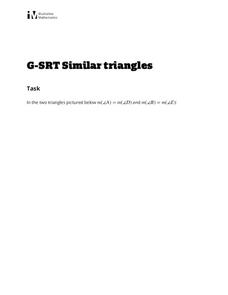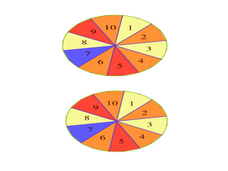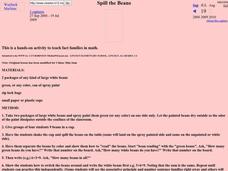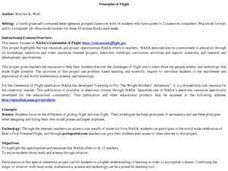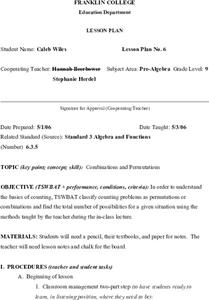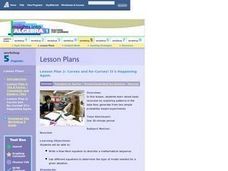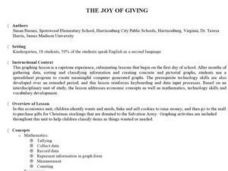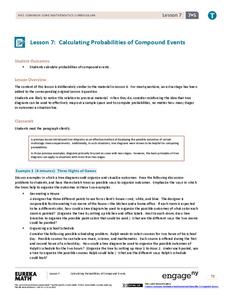Illustrative Mathematics
Similar Triangles
Proving triangles are similar is often an exercise in applying one of the many theorems young geometers memorize, like the AA similarity criteria. But proving that the criteria themselves are valid from basic principles is a great...
Curated OER
Scientific Method: How Many Drops of Water Fit on a Coin?
Young investigators conduct an experiment using the scientific method. They see how many drops of water fit on a coin; have them conduct several different trials. This involves making a hypothesis, looking at controls, and introducing...
Math12
Basics of Probability
Give your middle schoolers a fighting chance at understanding probability. Offering numerous examples that clearly demonstrate basic probability concepts, this resource helps young mathematicians learn how to visualize the...
Curated OER
Tchoukball - Lesson 1 - Introduction, Basic Rules and Skills
What is Tchoukball? Never heard of it? Take a look at this unit and see if it's something worth teaching to you class. It could be fun to learn a new non-traditional sport. Pretty much all you need to know is here in this unit. Lesson 1...
Curated OER
An Introduction to Counting
Students define the counting principle and how it relates to integers. In this algebra lesson, students add and subtract using the addition and multiplication principles. They solve problems using combination and permutations.
Curated OER
Calculating and Applying Basic Probability
Eighth graders investigate the basic concepts of probability. In this probability lesson, 8th graders learn the associated probability. They work with spinners, colored cubes in a bag, flip coins, and choose colored candies while they...
Texas Education Agency (TEA)
Principles of First Aid and Medical Emergencies
Here is a great resource to guide your instruction on identifying medical emergencies and administering first aid when necessary. Topics covered include assessing the scene of an emergency, calling EMS, and addressing a range of...
Curated OER
Spill the Beans
Students explore the meaning of a fact family. In this Math lesson, students work in small groups to create their own fact family based on color of beans. The beans are colored and represent a given value. Students discover the...
Curated OER
Probability: The Study of Chance
Students practice the basic principles of probability by conducting an experiment, determining if a game is fair, collecting data, interpreting data, displaying data, conducting analysis, and stating and applying the rule for probability.
Curated OER
Dayna Lykins, Leanna Prater
Fourth graders compare and contrast gliding flight and true flight. They investigate the basic principles of aeronautics. The class participates in activities to observe lift and the effect of air. Students design and fly their own...
Curated OER
Introduction to Magnetism and Electronics
Students are introduced to the concepts of magnetism and electronics. As a class, they walk through the steps of the scientific method and define new vocabulary. In groups, they are given a bag of objects and they are to separate them...
Curated OER
Teddy Bears and Friends
Children begin by making direct comparisons between objects and putting a number of objects into order according to length. They are also introduced to measuring with multi-link cubes which allows them to compare objects which cannot be...
Curated OER
Enumeration
In this calculus lesson, students review counting using the principles of Enumeration. They use random selections to count and convert word problems and count. There are 21 problems with an answer key.
Curated OER
Who Are We? An Introduction to the Life Within Our Bodies
Students examine cell structure, cell division, and the basic structure of DNA. They read and discuss a case study of DNA research, answer discussion questions, role-play the process of mitosis, and complete a DNA Fact or Fiction worksheet.
Curated OER
Introduction to Contracts
Students are introduced to the concept of contracts in street law. In groups, they compare and contrast contract law with tort law. They identify the basic concepts of each and view examples to see the concepts in use. They also disccuss...
Curated OER
Tree Leaves: Determining the Characteristics They Share in Common
Students use their basic knowledge of dendrology concepts and terms. In this tree leaf lesson students divide into groups and determine which characteristics go with what plant.
Curated OER
Combinations And Permutations
Seventh graders investigate the mathematical concept using a lecture format. The lesson includes a classroom management section with suggestions for lesson execution. Students write a definition for the Fundamental Counting Principle....
Curated OER
Curses and Re-Curses! It's Happening Again.
Students study basic recursion by exploring patterns in the data they generate from two simple probability-based experiments. In the first, students flip a coin to discover how many times they must flip it before it lands on "heads."...
Curated OER
The Joy of Giving
Children identify wants and needs, bake and sell cookies to raise money, and then go to the mall to purchase gifts for Christmas stockings that are donated to the Salvation Army. They then perform Graphing activities to help children...
Curated OER
Lesson Plan on Wants and Needs
First graders examine and discuss the difference between what they need to live and what they want. They examine pictures from magazines and newspaper ads, distinguishing between whether they are wants or needs.
Curated OER
Needs and Wants
Students examine the difference between needs and wants. In this consumption activity, students illustrate their needs and wants and discuss their own reasons for buying things. They also discuss the connection between their choices...
Curated OER
What Do You Need?
Students discover the difference between needs and wants. Using pictures, they develop a list of the needs and wants shown in each. They answer and discuss the answers to the questions as a class to end the lesson.
Curated OER
Observing Plants
Students identify how plants affect the survival of a caterpillar and what plants need to survive. They plant three bean seeds in the three containers, placing two containers at a sunny window and the third one in a dark closet and label...
EngageNY
Calculating Probabilities of Compound Events
Use tree diagrams with multiple branches to calculate the probabilities of compound events. Pupils use tree diagrams to find the sample space for probability problems and use them to determine the probability of compound events in the...
